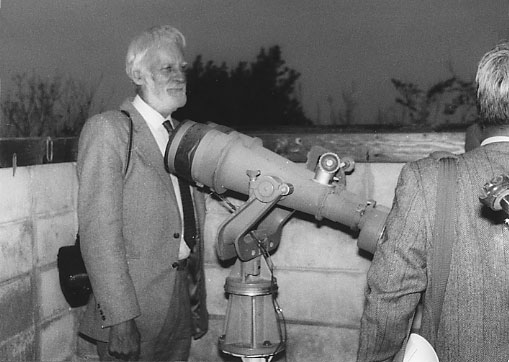
| Typhoon No.4 (CONSON) crossed the land near Muroto Promontory.
Though it rained but wind didn't blow much. As it started clearing in the
evening, I rushed to the observatory. As expected, there were many clouds,
but I was able to observe C/2002 T7 (LINEAR) in the southwest and C/2001
Q4 (NEAT) in the northwest through the 20cm telescope. C/2002 T7 (LINEAR) was 9.5 magnitude at 60x and showed hardly any tail. C/2001 Q4 (NEAT) was higher in the sky and clearly seen. It was about 7th magnitude and the coma was 8' in diameter. The tail was obvious but faint. After about 22:00 clouds increased and I returned home at 23:00. As the moon has become thinner, I will observe from midnight to dawn. Is Mr. Bradfield's comet still visible in the 20cm scope? I heard that he had discovered C/2004 F4 (Bradfield), while searching for comets of the Kroutz group. The photo below was taken when he visited my observatory at Geisei in 1989. I remember that he was looking at my 8.5cm comet seeker with much interest, which had discovered Comet Ikeya-Seki in 1965. When this comet appeared, he was interested in something else, not comets, he said. His motivation to see comets of the Kreutz group some day may have led to his recent discovery. Comets of this group are often visible in the southern sky. In Katmandu, Nepal King joined a ceremony to drive away comets' evil spirits in October 1965, as seen on NHK TV. Incidentally, Mr. Takao Namura, Shiga Prefecture's renowned craftsman, who ground this 8.5cm scope's lens, visited me at home about 5 years ago and reunited with his lens for the first time in 40 years. I still believe firmly that this superb lens led to my discovery. |

Mr. Bradfield at Geisei Observatory in 1989
Copyright (C) 2004 Tsutomu Seki.